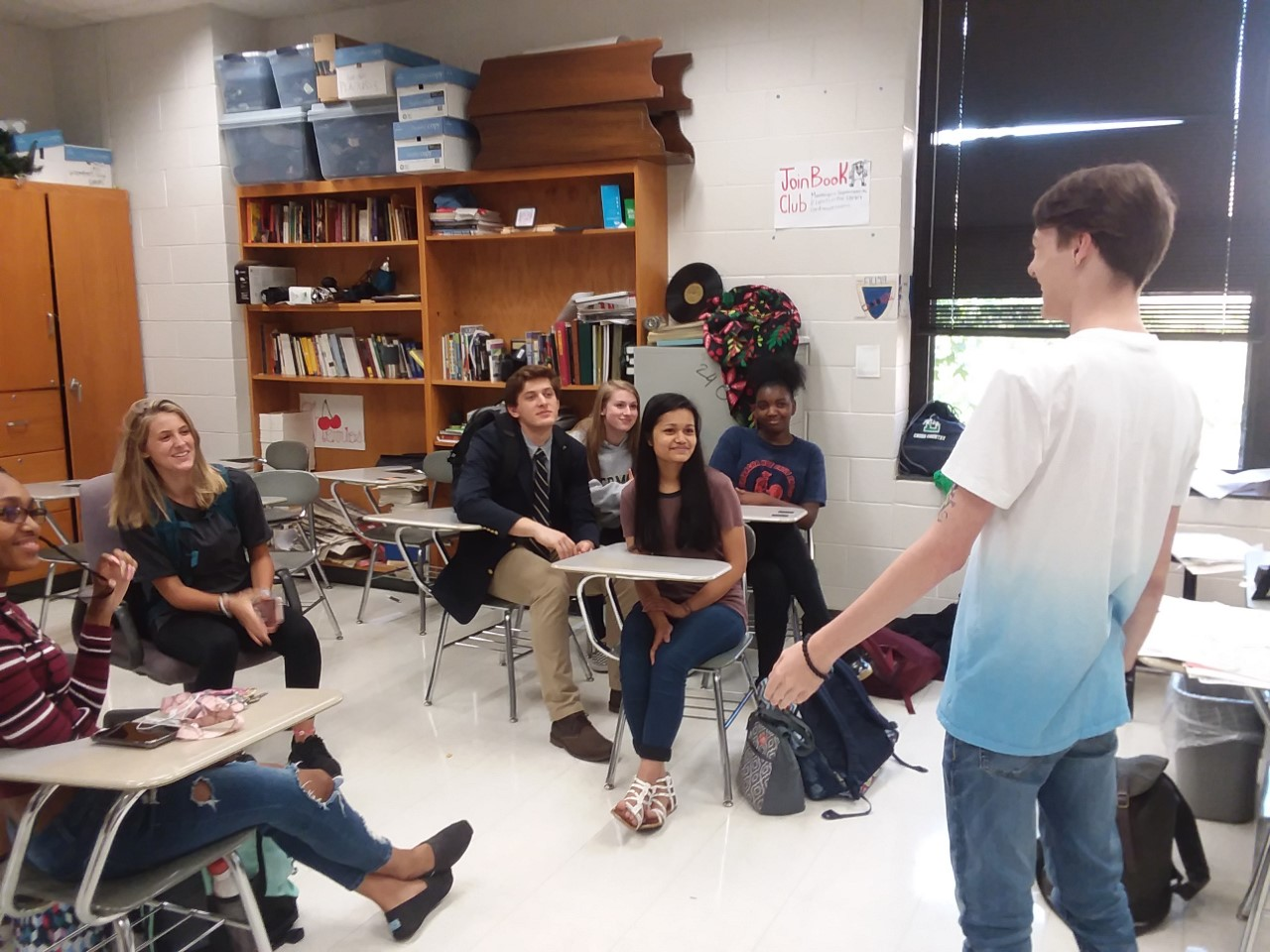(From left to right: DeKeriah Webb, Leah Ervine, Taylor Potts, Sarah Cash, Tahalia Nira, Trinity Cash, Jacob Smith) Leesville students sit in a focus group to learn about Socialistic ideas and see if they agree or disagree with the concepts. (Photo courtesy of Jacob Smith)
In 2018, one of the most influential congresswoman in politics was elected to Congress — Alexandria Ocasio-Cortez. At twenty-nine years old, Ocasio-Cortez is the youngest member of Congress and is famous for her massive social media following as well as her Democratic-Socialist ideas. Tom Perez, the Democratic National Convention chair, has called Ocasio-Cortez “the future of the party”, but is that really true?
While AOC was winning her election with more than seventy percent of the vote on Election Day, forty-one other moderate Democrats were fighting for every vote they could get in districts that had been held by Republicans. Those forty-one Democrats flipped the districts to win the House majority. What many people don’t know is that thirteen of those forty-one are millennials. There are now twenty-six millennial members of the House, meaning that half of the youngest members of Congress are moderates. Does Perez’s statement that AOC is the future of the party still hold water then?
To test this, a survey is given out to Leesville seniors in their civics classes. The Mycenaean survey tested four big ideas that Democratic Socialists like AOC and Bernie Sanders advocate for. The first policy surveyed was Medicare For All or Universal Healthcare. When asked if they would pay higher taxes for more available healthcare, seniors were pretty evenly split.Twenty-eight percent of seniors responded yes and twenty-eight percent responded no, but overall it was apparent that most of them didn’t know enough to answer with forty-four percent of respondents saying unsure.
Two of the other big policies that AOC has cheered for are the Green New Deal and forgiving college debt. These two seemed to be very popular with the Leesville seniors surveyed. Fifty-eight percent of respondents said they think the government should pay off student loan debt with twenty-four percent saying no, and eighteen percent responding with unsure. Sixty-seven percent said the US should transition from fossil fuels to renewable energy with nine percent saying no, and twenty-four responding with unsure.
The one idea seniors seem to disapprove of is the overall idea of socialism. Socialism’s definition is “a system or condition of society in which the means of production are owned and controlled by the state”. When polled if they would pay higher taxes for more government run services, forty-four percent of respondents said no with forty percent saying unsure, and only sixteen percent saying yes.
How accurate are these answers though? Many of the seniors answered the questions with “unsure”, if they had known the full scope of these questions, could have the results been drastically different? To test this theory a focus group was put together.
Seven Leesville students who had not taken the original survey are asked three of the questions from the survey without any background information. When first asked about Medicare For All, all seven said they would in fact pay higher taxes so everyone could have access to healthcare. The focus group was a bit more split on the Green New Deal, with four saying they think the US should transition from coal and oil to renewable energy, and three saying no. Lastly the focus group are polled on whether or not the government should forgive student loan debt. Five responded with yes and two with no.
The seven students were then told the pros and cons of each policy. After being told the Medicare For All plan would give healthcare to every US citizen, but would eliminate private insurance and cost trillions of dollars, the answers went from all yeses to three saying yes and four saying no.
Next is the Green New Deal. They were told that eliminating fossil fuels would help slow global warming, help stop pollution which disproportionately affects lower income communities of color but would eliminate many jobs in the coal industry in states like West Virginia and Kentucky. The answers went from four yeses and three noes, to five saying yes and two saying no.
These results are telling. After they are informed of the actual benefits and repercussions of these policies their answers changed.
The two results from the focus group and survey ended up lining up pretty evenly. Universal healthcare remains unpopular with the majority of respondents, while the majority of Leesville students polled approved of student loan debt forgiveness and transitioning to renewable energy, with renewable energy being approved of the most.
These results aren’t surprising though. High school students worry about crushing student loan debt and their future on this planet more than they would about paying for medical bills, something they’ve most likely never had to deal with before.
So are young people moving left towards Democratic Socialism or moving to the center? From what The Mycenaean found, the answer is both.
Like most voters they care most about issues that affect them the most such college and the environment. These are the issues they might agree with AOC on but Socialism in general? Probably not. Leesville seniors, who are eligible to vote in 2020, disapproved of Socialism’s definition.
Young people could be a huge force in elections if they voted at the levels that seniors do, but if this article has proven anything it’s don’t assume that they’ll always go for the far left candidate. They’ll vote for the candidate who appeals to their needs the most, whether that’s a Democrat or a Republican, who knows?

Hi! My name is Jacob Smith and I am a staff writer for The Mycenaean. I am also a political activist and volunteer.

Leave a Reply